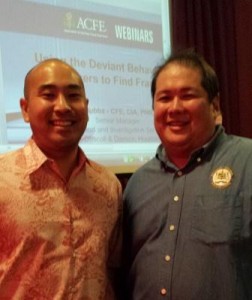January 2014 Luncheon
January 20, 2014
 Christopher D.W. Young currently serves as a Supervising Deputy Attorney General and Division Chief of the Criminal Justice Division, Department of the Attorney General, State of Hawaii. At our January 2014 luncheon, he focused his talk on the Fraud Examiners’ Role in Prosecuting Fraud. He advised those investigating fraud to not “get lost in the forest” and try not to find all theft but look for obvious theft that can more easily lead to prosecution.
Christopher D.W. Young currently serves as a Supervising Deputy Attorney General and Division Chief of the Criminal Justice Division, Department of the Attorney General, State of Hawaii. At our January 2014 luncheon, he focused his talk on the Fraud Examiners’ Role in Prosecuting Fraud. He advised those investigating fraud to not “get lost in the forest” and try not to find all theft but look for obvious theft that can more easily lead to prosecution.
He described the 5 Steps for Developing a Provable Fraud Case:
- Find and understand policies and procedures. This includes organizational rules, bylaws, who has oversight over funds, legal duties (particularly fiduciary), board minutes and financial reports. It is critical to obtain evidence that the suspect was made aware of the rules, e.g. through training.
- Find the paper trail — both what exists, and what should be there but is missing. Missing documents could be an indication of intent to defraud. Remember to track down documents that are not held by the suspect.
- Challenge the paper trail, verify what is documented. This could involve checking with a third party vendor or finding backup documents.
- Apply records to the rules obtained in Step 1. Failure to comply or partial compliance, or exceeding authorization limits could be considered intent to defraud.
- Interview a potential suspect only within the parameters of your organization’s existing administrative process. Under no circumstances during fact-finding should you consult law enforcement on what types of questions to ask, as this makes you an agent of law enforcement, which requires that a suspect be read his or her Miranda rights. If you do interview, obtain agreement at the outset, e.g. establish that the person was aware of the rules before inquiring about specific details. Record the interview if possible. Don’t accuse the person, allow him or her to provide an explanation and keep your reporting factual.
This forms the basis for a summary of findings, which the prosecutor can use to build his or her case. He noted that felony charges — which could be for amounts as little as $20,000 — must be brought within three years of discovery, so time is of the essence. Do not delay reporting, as law enforcement has better tools for obtaining records and testimony.